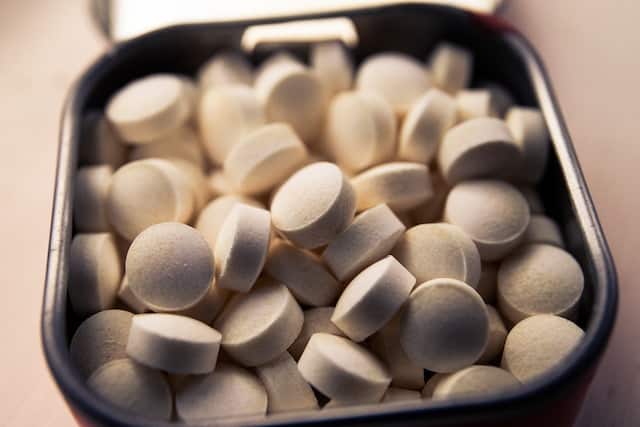
Chlorine is a well-known water disinfectant, used all over the world however it comes in many forms that are lesser known to the general population. One method of chlorinating water is chlorine pills, also commonly known as water purification tablets which are added to water containers for personal or household use. In order to shed some light on this topic, I looked into it, did a bit of research on the topic and came up with this general overview of chlorine tablets, what they do and reasons you should or shouldn’t use them!
Water purification or chlorine tablets are small pills that are a portable, user-friendly way to utilize chlorine’s properties to kill bacteria and viruses in a container of water. Purification tablets are an easy way to disinfect water when on-the-go without the need for additional equipment or expertise.
What Are They?
Water purification tablets, also known as chlorine tablets are a common method for disinfecting drinking water. They are small, compressed tablets containing a known amount of chlorine that dissolve in water. Chlorine is a powerful disinfectant that kills bacteria, viruses, and other harmful microorganisms that can be present in drinking water. Chlorine pills are readily available online, at most pharmacies and even at outdoor/camping stores.
How Do They Work?
Chlorine tablets work by releasing hypochlorous acid (HOCl) and hypochlorite ions (OCl-) into the water. These substances react with and destroy the cell walls of bacteria and viruses, rendering them harmless. Chlorine tablets typically contain a mixture of calcium hypochlorite and other inert ingredients.
If you are interested in reading more about how chlorine works I encourage you to read my article What Is Chlorination: A Simple Explanation.
What Are The Advantages?

The main advantage of water purification tablets is their convenience, they are easy to use and transport, and they have a long shelf life. Water purification tablets are also effective at killing a wide range of microorganisms, making them a reliable method for disinfecting water in a variety of situations where traditional disinfection techniques are not available or suitable.
One of the most common uses for water purification tablets is hiking in remote areas where clean water is not available, a small box of chlorine pills weighs next to nothing and can easily provide sufficient filtration for extended hikes, weeks or months in length.
Another common scenario that takes advantage of water purification tablets’ ease of use and portability is in areas of natural disasters where existing water infrastructure has been destroyed. Chlorine tablets can easily be distributed to large populations as a way to ensure access to drinking water that is free from potentially harmful bacteria and viruses
What Are The Disadvantages?
Aside from general disadvantages associated with chlorine in general, water purification pills have some other drawbacks, some subjective like taste & smell and others regarding the potential for their misuse.
The most notable disadvantage of chlorine pills is that they can affect the taste and smell of the water. Chlorine has a distinctive odour and taste, which can be off-putting to some people, this becomes more noticeable at higher levels which a standardized solution like chlorine pills can lead to if used at higher concentrations in a smaller water bottle for instance. Although as mentioned further down this article, there are ways around this issue if you find the taste & smell of chlorine to be unpleasant.
Another disadvantage somewhat relates to the above in terms of over-usage. There is the risk of overuse or misuse of water purification pills. If too many chlorine pills are used or if they are not used correctly, the water can become over-chlorinated, which can make it unsafe to drink, although this would require an over-the-top amount of overuse and is generally unlikely unless in the hands of children. Additionally, if the chlorine pills are not stored correctly, they can lose their effectiveness over time, which can lead to inadequate disinfection, however, each box of pills will let you know the correct storage conditions so this is also easy to avoid.
What Makes Them Different From Regular Chlorine?
Water purification tablets are different from regular chlorine in a number of ways. Firstly, water purification tablets typically contain a combination of different chemicals, including chlorine, which are designed to work together to kill bacteria, viruses, and other harmful pathogens in the water. In addition to chlorine, these tablets may also contain other chemicals such as iodine, which can help to kill viruses that are resistant to chlorine.

Another difference between water purification tablets and regular chlorine is the concentration of the chemicals. Water purification tablets are designed to release a specific concentration of chemicals into the water, which is usually sufficient to kill most pathogens. This concentration is carefully controlled to ensure that the water is safe to drink while minimizing the risk of over-chlorination.
Regular chlorine, on the other hand, is typically used in much higher concentrations for disinfection purposes, such as in swimming pools or wastewater treatment plants. These higher concentrations are necessary to ensure that all the pathogens are killed, but they can also be harmful if the water is consumed.
Finally, another key difference between water purification tablets and regular chlorine is the form in which they are delivered. Water purification tablets are typically in solid form, whereas regular chlorine is usually delivered in liquid form. This makes water purification tablets much easier to transport and store, as they are less likely to leak or spill.
How Do They Affect Taste & Smell?
Chlorine can affect the taste and smell of water, but this is generally only noticeable at higher concentrations. At the low levels typically used for disinfecting drinking water with purification tablets, the chlorine should not significantly impact the taste or smell of the water.
Whether chlorine negatively impacts the taste of water is a subjective view, person to person, however, if you are interested in methods to remove chlorine from water I encourage you to have a read of my article The 4 Easiest Ways To Remove Chlorine From Water.
Are They Safe?
Water purification tablets are generally considered safe when used as directed. However, it is important to follow the manufacturer’s instructions carefully and avoid using too many tablets, as this can result in excessively high levels of chlorine in the water.
The general consensus among experts is that chlorine pills are safe when used as directed. The World Health Organization (WHO) has published guidelines for the use of chlorine in drinking water, which include specific recommendations for the use of chlorine pills. The WHO guidelines state that chlorine pills can be used to disinfect drinking water in emergency situations, as long as they are used correctly and in the correct dosage.
Similarly, the US Environmental Protection Agency (EPA) has established regulations for the use of chlorine in drinking water. These regulations set maximum contaminant levels for DBPs and other potential contaminants and require water systems to monitor their water for these contaminants on a regular basis.
References:
WHO. (2011). Guidelines for Drinking-water Quality, Fourth Edition. Link: https://www.who.int/publications/i/item/9789241548151
EPA. (2018). Chlorine in Drinking Water. Link: https://www.epa.gov/dwreginfo/chlorine-drinking-water
CDC. (2019). Emergency Water Treatment. Link: https://www.cdc.gov/healthywater/emergency/drinking/make-water-safe.html
UNICEF. (2014). Guidelines for Drinking Water Quality in Emergencies. Link: https://www.unicef.org/media/6931/file/GDWQE2014.pdf
NSF International. (2021). NSF/ANSI 60 – Drinking Water Treatment Chemicals – Health Effects. Link: https://www.nsf.org/knowledge-library/nsfansi-60-drinking-water-treatment-chemicals-health-effects

